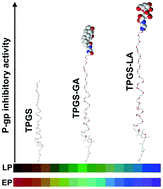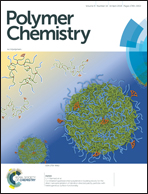Mechanisms of TPGS and its derivatives inhibiting P-glycoprotein efflux pump and application for reversing multidrug resistance in hepatocellular carcinoma†
Abstract
D-α-Tocopheryl polyethylene glycol 1000 succinate (TPGS) and TPGS based conjugates have been widely researched for treatment of multidrug-resistant (MDR) cancer. Nevertheless, the influence of structural modification of TPGS on its properties and function requires further exploration. In this study, a hypothesis for the interaction between TPGS and P-glycoprotein (P-gp) at the molecular level has been proposed based on the existing limited knowledge of TPGS inhibition on P-gp. Two TPGS derivatives, TPGS–glycyrrhetinic acid conjugate (TGA) and TPGS–lactobionic acid conjugate (TLA), were synthesized. Molecular docking and molecular dynamics (MD) simulations were employed to investigate the P-gp inhibitory ability of TPGS and its derivatives and their inhibitory mechanism. Moreover, a systematic in vitro experiment was conducted to further confirm simulation results and evaluate antitumor effects. It was found that TLA and TGA displayed higher binding affinities with P-gp than TPGS, which was attributed to their properties of hydrophilicity and negative charge. Meanwhile, TPGS and its derivatives prevented the P-gp ATPase from hydrolyzing ATP by blocking the ATP binding sites, thereby inhibiting P-gp function. It was also found that the high hydrophilic–lipophilic balance (HLB) of the polymer contributed to a significant MDR reversing effect. In addition, TLA and TGA could promote intercellular accumulation and noticeably enhance the cytotoxicity of DOX in HepG2 and HepG2/ADR cells compared to TPGS. This work may be an important step in understanding the structure–activity relationships (SARs) of TPGS and its derivatives, the roles of the three polymers in MDR reversal mechanisms and in designing promising excipients for reversing MDR. The results suggested that TLA and TGA can be used as potential P-gp inhibitors or nanocarriers in the field of drug delivery.



 Please wait while we load your content...
Please wait while we load your content...